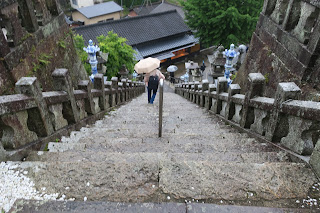The Sueyama Shrine is located in Arita Town, Nishimatsuura District, Saga
Prefecture. Sueyama Shrine has a porcelain archway and other items of
porcelain which, at other shrines, are usually made of stone. This shrine was
and still is particularly revered by Arita’s ceramists.
|
Crossing the Sasebo train line to enter the sanctuary.
|
|
Approaching the first torii.
|
|
Lion-dogs keep out evil spirits.
Meant to ward off evil spirits, modern komainu statues usually are
almost identical, but one has the mouth open, the other closed (however,
exceptions exist, where both komainu have their mouth either open or
closed). The two forms are called a-gyō (lit. '"a" shape') and un-gyō
(lit. '"un" shape') or referred to collectively as a-un.
|
|
Approaching the second torii.
|
|
Votive tablets.
Ema (lit. 'picture-horse') are small wooden plaques, common to Japan, in
which Shinto and Buddhist worshippers write prayers or wishes. Ema are
left hanging up at the shrine, where the kami (spirits or gods) are
believed to receive them.
-
Typically 15 cm (5.9 in) wide and 9 cm (3.5 in) tall, they often carry
images or are shaped like animals, or symbols from the zodiac, Shinto,
or the particular shrine or temple.
|


Ceramic information plaque.
«SUEYAMA JINJA - SUEYAMA SHRINE (common name: TOZAN SHRINE)
Tozan Shrine was founded in 1658 as
Arita Sarayama Sobyo Hachimangu and is a branch of Kamihara
Hachimangu Shrine in Imari which is dedicated to Ojin Tenno. It is only
since the Meiji period that this Hachiman Shrine (Shrine for the God of
Archery) was called Tozan which means "pottery producing area".
Additionally the ancestor of the feudal clan Nabeshima Naoshige and the
father of Arita porcelain Ri Sanpei are worshipped here.
In the precincts of the shrine several memorial monuments and monuments
to the honour of great people of Arita are to be found. These include
the monuments for Narimatsu Nobuhisa who was a famous local
governor in the Edo period, Egoshi Reita the great scholar,
Fukagawa Eizaemon 8th who contributed to the pottery industry and
Fukagawa Rokusuke who started the Arita Porcelain Fair. Also on
top of the mountain the monument of Ri Sampei was erected in 1917 in
commemoration of the 300th anniversary of the first production of
porcelain in Arita. Thus the virtue and power of the former leaders of
Arita is honoured here.»
|
|
Staircase to go up to the sanctuary.
|
|
Porcelain lantern.
Lanterns (Chinese: dēnglóng; Japanese: tōrō, meaning
'light basket', 'light tower') are a type of traditional East Asian
lantern made of stone, wood, or metal.
|
|
Porcelain archway.
Sueyama Shrine has a porcelain archway and other items of porcelain
which, at other shrines, are usually made of stone.
-
The third torii (Shinto shrine archway), built in 1888, had been
designated Tangible Cultural Properties on April 28, 2000.
|
|
The hall of worship or oratory (haiden).
In Shinto shrine architecture, the haiden is the hall of worship
or oratory. It is generally placed in front of the shrine's main
sanctuary (honden) and often built on a larger scale than the
latter.
|
|
Water ablution pavilion.
Chōzu-ya or temizu-ya is a Shinto water ablution pavilion for a
ceremonial purification rite known as temizu or chōzu
(lit. 'hand-water'). The pavilion contains a large water-filled basin
called a chōzubachi (lit. 'hand water basin').
|
|
Porcelain columns with dragon motif.
|

Ceramic information plaque.
«TÔZANJINJA TO JIKI TORII (TÔZAN SHRINE AND PORCELAIN SHRINE ARCHWAY)
Enshrined gods: Ôjin Tenno, Nabeshima Naoshige, Ri Sanpei
Festivals: Festival for the ancient potters (May 4). Annual shrine
festival (Oct. 16/17)
Foundes: August 1658 as a branch of "Arita Gôsha Hachimangu Shrine” in
Imari.
History: Tozan Shrine was founded in the Edo period under the name of
Arita Sarayama Sôbyô Hachimangu and dedicated to the fathers of
pottery to pray for the town and the prosperity of Arita porcelain. It
is situated in a picturesque location on the foot of
Renge'ishi Mountain where one has a good view over the town.
Cherry blossoms, azaleas and altheas, the national flower of Korea which
Arita has a close relation to, colour the shrine area throughout all
seasons. If you have a look around you will discover the porcelain
guardian dogs (1887. dedicated by Imaemon 10), the porcelain Torii
(shrine archway. 1888, dedicated by the district of Hiekoba) and the big
water basin (1889. dedicated by the district of Nakanohara, created by
Ide Kinsaku). All of which are pieces of great elegance, which make the
shrine resemble a natural open-air museum.»
|
|
Big porcelain water basin.
|
|
Inari Shrine, honden and haiden.
Inari Shrine (left), honden (center) and haiden (right).
-
In Shinto shrine architecture, the haiden is the hall of
worship or oratory. It is generally placed in front of the shrine's
main sanctuary (honden) and often built on a larger scale than
the latter.
-
In Shinto shrine architecture, the honden (main hall),
also called shinden, or sometimes shōden as in Ise
Shrine's case, is the most sacred building at a Shinto shrine,
intended purely for the use of the enshrined kami, usually
symbolized by a mirror or sometimes by a statue.
|
|
Inari Shrine.
Inari Ōkami, also called Ō-Inari, is the Japanese kami of foxes,
fertility, rice, tea and sake, of agriculture and industry, of general
prosperity and worldly success, and one of the principal kami of Shinto.
In earlier Japan, Inari was also the patron of swordsmiths and
merchants.
|
|
Haiden and view over the Renge'ishi Mountain.
|
|
Honden and haiden.
Honden (left) and haiden (right).
|
|
Haiden and porcelain torii.
Haiden (left) and porcelain torii (center).
|
|
Leaving the Sueyama Shrine.
|
See also
Source
Location

































